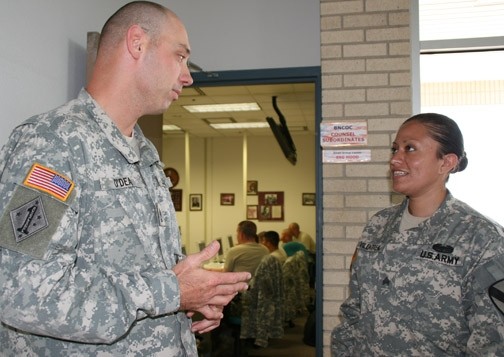FORT SAM HOUSTON, Texas --- They've overcome the difficulties of life on the battlefield, long separations from loved ones and even brushes with death.
But despite severe injuries and months out of the physical training loop, seven wounded warriors are willingly taking on a new challenge - NCO Academy.
The Soldiers are the first Warriors in Transition to attend a class at the Army Medical Department NCO Academy here, marking another step toward the reintegration of wounded warriors back into the Army Family.
"We knew it would be extremely challenging, but also an honor to take it on," said Sgt. 1st Class Thomas O'Dea, senior small group leader for the academy's Basic NCO Course. "We're pioneering something here that will make it easier in the future for other Warriors in Transition."
The wounded warriors are among the 65 Soldiers attending the three-week Stand Alone Common Core course, which is required for all Army NCOs once they reach the E-5 or E-6 rank. The class includes interactive lessons in supervision, physical training, and drill and ceremony. The goal of the course is to instill Soldiers with the knowledge to successfully lead subordinates, O'Dea said.
"The standards are high, so the challenge has been how to integrate the Warriors in Transition so they can successfully meet those standards, taking into account their physical capabilities," he said.
The Soldiers are up before dawn for PT, then on to a full day of classroom instruction. Each hour on the hour, the Soldiers recite the NCO Creed and sing the Army Song, all part of cadre efforts to instill the importance of pride in service.
For the Warriors in Transition attending the course, they already bear evidence of that pride and selfless service with the wounds they bear. Unlike the other Soldiers, who are required to attend, the seven wounded warriors are volunteers eager to step away from hospital life for a short time.
One course student, Sgt. Kristopher Biggs, walks with a limp as he enters the classroom, a remnant of his encounter with a vehicle-borne improvised explosive device in Iraq. The explosion shattered just about every bone in his left leg. In recovery since December, Biggs said he is seeking a new purpose.
"I was combat arms before and can't do my job anymore," said Biggs, who plans to start college courses soon. "I thought this would be a good opportunity to get back into a learning environment and also help my Army career."
A full-time patient prior to the course, Biggs said it was also a way to find a new "agenda."
"At the hospital, I haven't really seen anything military since before I got injured," he said. "It's great to be back in the productive Army."
Another student, Sgt. Rosangela Villarreal, does not bear any evident signs of injury, but still carries shrapnel in her right side. The nudges of pain are a nearly constant reminder of her run-in with an IED in Iraq in October 2006.
But the pain does not prevent her from continuing her service. She was just cleared to return to duty as a military policeman, news that thrills Villarreal.
"I love what I do," she said. "It gives me a sense of pride that no one can take away."
Villarreal said she's appreciative of every minute of the course, but particularly enjoys the morning runs. "I haven't run in seven months," she said. "It's a great feeling to get back out there."
Like Biggs, Villarreal sees the advantage for her Army career. She's due to go in front of a promotion board next month and hopes for the best.
"This course is a way to get back into the NCO mode," she said. "When I get promoted, leadership should be a smooth transition."
Cadre members are observing closely and will integrate lessons learned into future classes with Warriors in Transition, O'Dea said.
He's noticed so far that the other Soldiers are benefiting just as much as the wounded warriors.
"They have a multitude of experiences they can share with those Soldiers who have yet to deploy," he said. "The Warriors in Transition have life experience and can bring a different perspective to the table. They are living proof of the importance of leadership, which is exactly what we strive to teach."
The wounded warriors also bring an example of survival and human fortitude.
"I re-enlisted in Iraq before I got hurt, and I'd do it again in a minute," Villarreal said. "I chose this life. I didn't choose to get hurt, but it's not keeping me down."




Social Sharing